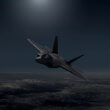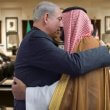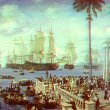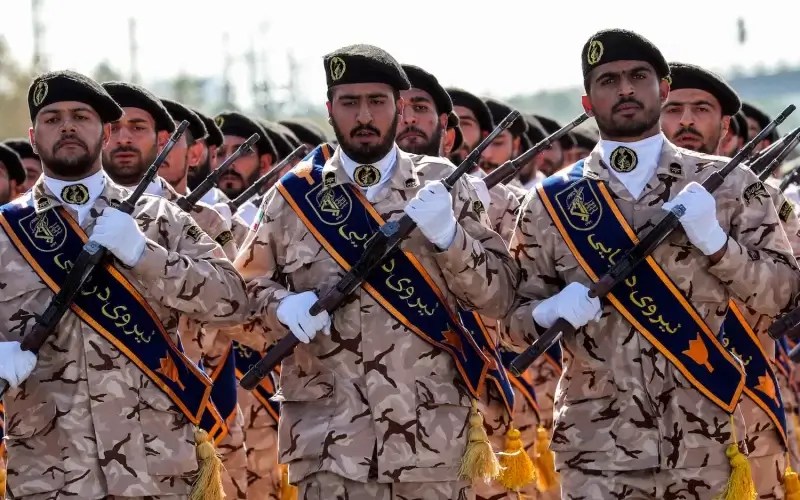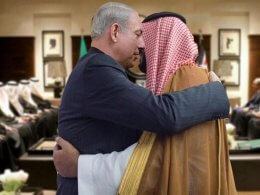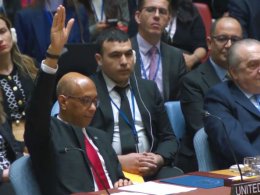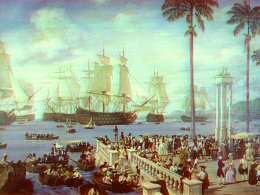With the Biden administration poised to revive the 2015 nuclear agreement with Iran, the President and his team are considering whether to delist Iran’s Revolutionary Guards Corps (IRGC) from the Foreign Terrorist List.
Since its creation, the IRGC has become one of the deadliest terrorist entities with ties to Hezbollah, Hamas, Bashar al-Assad’s government, China, Russia, and many other countries. The history of the IRGC is one ripped radical Islamic extremism dating back to the 1979 Iranian Revolution.
On February 1, 1979, the radical exiled Islamic cleric Ayatollah Ruhollah Khomeini returned to Iran after 15 years of being expelled for speaking out and protesting the country’s ruling monarch, Shah Mohammed Reza Pahlavi. The exiled cleric and his radical Shiite followers overthrew the monarchy because of his Western policies, his close ties with the United States, and his support of the state of Israel. Under Khomeini and his followers, Iran became a radical Islamic Republic that was hellbent on spreading Ayatollah’s vision of an Islamic Middle East, eradicating U.S. influence and the state of Israel.
Even in exile, the Ayatollah dreamt of creating a military force that would uphold his Islamic beliefs and spread his revolutionary ideas throughout the globe. From Khomeini’s perspective, this Revolutionary Islamic force would answer only to the Imam and his religious cohorts. When the Ayatollah finally landed in 1979, the cleric had now had his chance to make his dream a reality that would impact the world for years to come.
While many leftists, nationalists, and Islamists competed over the makeup of the new revolutionary republic, Khomeini and the clerical establishment created a military institution that would serve as a custodian of the Revolution and its Islamic beliefs.
The makeup of this new military entity would only include young Shiite men whose sole purpose was to guard the Islamic Republic and conduct the Ayatollah's mission of spreading his radical Islamic beliefs. The name of this terrorist entity would be known as the Iranian Revolutionary Guards Corps (IRGC).
The IRGC functioned as the people’s army that would not only help consolidate the Revolution but also protect the new regime from a coup d’état just as happened to former Iranian Prime Minister Mohammed Mossadegh’s government in 1953.
Those who joined the Revolutionary Guards were young radical Shiite men who studied under Khomeini during his tenure at the University of Qom and joined the military organization for what they described as a greater purpose for Islam.
The IRGC also unified and organized Islamic gangs and paramilitary groups formed after the Revolution. This new united force would serve as a counterweight to the regular Iranian, previously loyal to the Shah. During the Iran-Iraq War from 1980 to 1988, the IRGC became a more powerful conventional fighting force adopting a similar command structure to Western militaries.
The IRGC did have a conflict with Iran’s first president Baolhasan Bani-Sadr, who looked down on the Islamic clergy and their influence in the government, leading to his eventual impeachment and removal from office.
In August 1981, Iranian prime minister Mohammad Ali Raja’i and Iranian President Ali Khamenei came into power with favorable views of the IRGC, aiding the organization with new and expansive economic and military resources. With brand new economic and military resources, the Iranian Revolutionary Guards Corps went from bolstering the efforts of the regular army forces to growing in power, structure, and complexity as it helped Iran gain significant ground in the war.
While the IRGC was heavily involved in the Iran-Iraq War, Khomeini and his Islamic followers still conducted their mission of spreading the Islamic Revolution to other parts of the Middle East and involved themselves in the Lebanese Civil War. The IRGC created several branches for itself, each of which had different military missions. One of the most famous branches was the Quds Force, an elite covert wing of the IRGC whose primary responsibility includes foreign operations such as liberating Jerusalem.
The Quds Force became continually active in the Lebanese Civil War in 1982, training and helping Shiite Lebanese groups and PLO terrorists push back the Israeli army out of Lebanon using terrorist bombs and other gruesome tactics.
While in Lebanon, the IRGC helped rally, train, and support the newly created Party of God or Hezbollah in Southern Lebanon. Under the IRGC, Hezbollah obtained military aid training, which helped the group attack the U.S. embassy in 1983 and created a staging ground for future terrorist attacks against Israel.
After a ceasefire was created between Iran and Iraq in 1988, the Islamic Republic under its new Supreme Leader, Ayatollah Ali Khamenei increased its economic and military influence while also intervening in political affairs. In later years, the Supreme Leader authorized the establishment of an intelligence apparatus to strengthen the IRGC’s strategic planning. With more money coming from the Islamic Government, the IRGC continued its crusade of chaos and conquest aiding groups like Hezbollah in Lebanon, Hamas in the Gaza Strip, the Houthis in Yemen, and other Islamic groups.
When the U.S. toppled Saddam Hussein’s regime in 2003, the IRGC grew its influence in postwar Iraq, supporting terrorist groups against U.S. coalition forces and various Iraqi Shiite political parties in the new government. From 2005 to 2013, Iran President Mahmoud Ahmadinejad, a veteran of the IRGC, placed many members of the terrorist entity into senior positions in Iran’s government and awarded the group numerous government contracts and billions of dollars in loans to expand the military power of the organization.
During the 2009 Green Movement protests in Iran, the IRGC was deployed to suppress and quash peaceful protesters protesting the results of the presidential election that gave Ahmadinejad another term. When the dust settled, Khamenei ordered the intelligence branch of the IRGC to expand to monitor, arrest, and execute citizens who spoke out against the Iranian government.
As Iran’s regime continued to expand its actions in 2010 and thereafter, international sanctions from the West were placed to curb the group’s activities and economic sanctions were placed on IRGC owned businesses. Facing international punishment and consequences, the IRGC obtained its economic resources through smuggling activities and relationships with countries like Syria, North Korea, Russia, Qatar, and Venezuela.
During the 2011 Arab Spring, IRGC troops were deployed to Syria to defend President Bashar Al Assad’s government from collapse allowing the group to have more influence in the area where it could train recruits and funnel weapons to groups like Hamas and Hezbollah surrounding Israel. From early 2010 to 2011, Iran has used Syria as a staging ground against Israeli forces using drones against Israeli civilians, military officials, and critical infrastructure.
In the Gaza Strip, Hamas and groups like Islamic Jihad have received continuous military and economic support from IRGC officials, providing military-grade weaponry such as rockets and missiles to use against Israel’s civilians and homes and using Hezbollah to aid in their attacks. In Yemen, the IRGC has provided financial aid and military training to the Houthi rebels, hoping to create a Shiite Islamic State bordering another enemy of the Islamic Republic, Saudi Arabia.
When the Obama administration and its allies created the 2015 Joint Comprehensive Agreement (JCPOA) with Iran regarding its nuclear program, the IRGC supported the agreement because of the benefits the Obama Administration provided to the regime. The IRGC saw the deal as a way to obtain a nuclear weapon, one that would bring their crusade against Israel and Arab countries to a decisive end. Shortly afterward, with new sanctions relief and billions of dollars in the Iranian treasury, the IRGC continued its campaign to spread Khomeini’s revolution throughout the Middle East.
After the 2016 election, the newly elected President Donald Trump and his administration took a stronger stance toward the IRGC. In 2018, President Trump withdrew from the JCPOA and enacted economic sanctions against IRGC-owned businesses and officials. Under Secretary Mike Pompeo, the Trump administration designated the IRGC as a foreign terrorist organization that engages in terroristic activities against U.S. officials, allies, and human rights.
In early January 2020, the Trump administration successfully targeted IRGC General Qasem Soleimani after months of IRGC activity against U.S. officials and allies in the Strait of Hormuz. Soleimani was one of the IRGC’s critical leaders who dedicated his life to spreading the Islamic Revolution using various terrorist tactics. The IRGC afterward was put on notice by the administration and has never really recovered from this crippling blow.
In 2020, when President Biden took office, the IRGC became more militant and increased its circle of friends to include terror groups like Hamas and Islamic Jihad.
The Biden Administration has been overly enthusiastic to revive the 2015 JCPOA, which will give the IRGC new funds to continue its terroristic agenda. With the deal on the verge of revival, the Biden administration is now heavily considering the removal of the IRGC from the U.S. Foreign Terrorist list, hoping that the Islamic Republic will rein the group’s activities and stop its nuclear enrichment of uranium.
Even with all these benefits offered by the Biden Administration, the IRGC continues to have free reign in the Middle East and will most likely increase its activities should this new deal become revived. As the IRGC expands its power, countries like Israel and the Arab world are uniting to deter the group’s activities, sending a message to Washington that this terrorist entity is not to be appeased or ignored.


